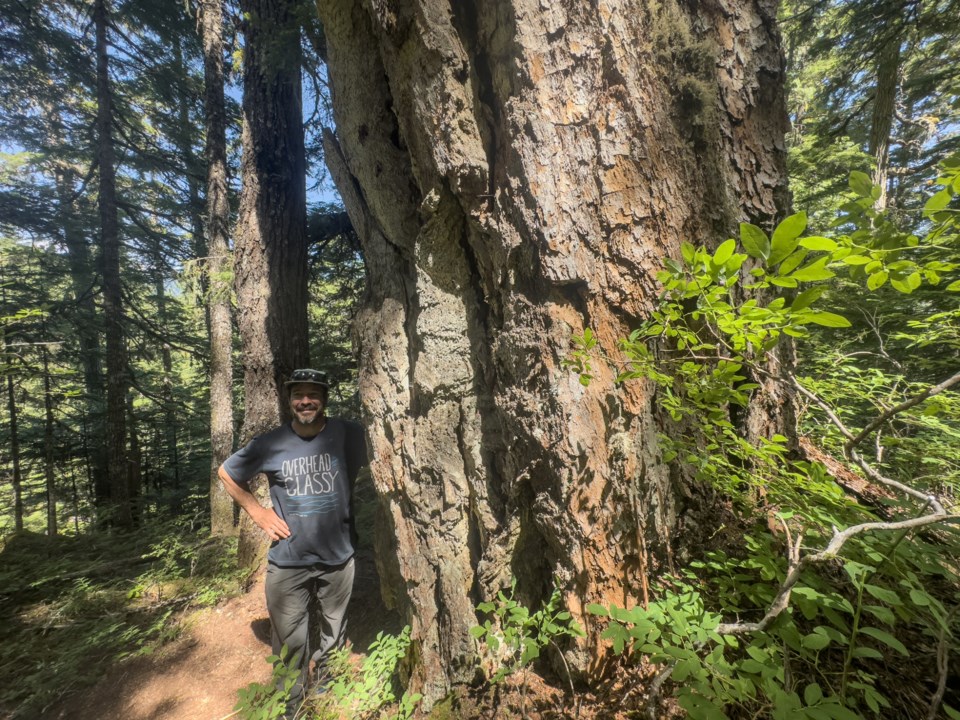Sometimes the rarest treasures have been right under our nose the entire time. In the case of a charismatic old-growth tree recently discovered in Whistler, close to a thousand years.
This summer, ecologist and Whistler Naturalists co-founder Bob Brett cored a sturdy Douglas fir near Loggers Lake, in the Cheakamus Community Forest (CCF), that initially indicated it was about 750 years old. However, Brett said he only got about halfway in before hitting rot.
“I’m still planning to go back and core from another angle with less rot, and hoping to get more rings,” he said. “I’m guessing it’s upwards of 900 years old, or even closer to 1,000.”
Although the tree wasn’t initially discovered by local Dan Raymond, Brett said the renowned trail builder was so “gobsmacked” by the centuries-old Douglas fir that he decided it was worth a closer look—and for good reason.
“This tree … is in a different league,” Brett said. “The bark is unbelievable. This is a really spectacular tree. It’s not even that big. It’s less than two metres in diameter.”
The area had been slated for logging by CCF foresters, but with the moratorium on old-growth logging first implemented in 2021 still in place indefinitely, the tree is protected for now. “I’m just thankful it happened,” Brett added. “You can imagine how magnificent the forests were in Whistler before most of the trees were removed. It’s amazing to me we still have remnants of them.”
Brett has been in talks with the CCF partners to provide them with more up-to-date information on tree ages in the community forest.
“They’re receptive to getting better age data in their mapping because the data is inaccurate in many places, specifically underestimating ages,” he said. “That will, hopefully, eventually, go in their database and hopefully that [stand will be] off the books for good, but I don’t know.”
The Douglas fir near Loggers Lake is far from the oldest tree in Whistler. The oldest tree Brett has cored in his decades of research, a yellow cedar in the Callaghan Valley, is around 1,300 years old. Yellow cedars make up the bulk of Whistler’s oldest trees, and Brett said he has “no doubt” there are other yellow cedars even older than that locally.
Before this most recent find, Brett said the oldest Douglas firs he had found were both about 720 years old—one near Spruce Grove Park and the other in the Ancient Cedars area.
“It’s exciting to get a tree that old in this part of the world,” he added.
In 2019, the Whistler Naturalists published the results of an extensive project that saw the non-profit photographing and coring hundreds of trees around the community that were listed and displayed in a slick-looking map. Part of the goal was to highlight Whistler’s old and ancient trees.
“The reason for all of this and all the coring I’ve ever done is related to trying to conserve old-growth forest,” Brett said at a 2018 AGM offering the public its first glimpse at the mapping project. “It’s hopefully written in a way that is neutral; it does mention logging, but it’s trying to make the case for why you’d want to leave those trees standing.”
The Resort Municipality of Whistler (RMOW) has also tapped Brett to consult on its Priority Habitat Initiative, a planning guide being developed “to protect biodiversity and improve Whistler’s resilience to climate change through the protection of natural services provided by these ecosystems, while balancing the resort community’s social and economic needs,” wrote an RMOW communications official, in an email. “This Initiative is to identify, protect and restore important natural habitat areas, and will include goals and subsequent recommendations.”
The initiative differs from the RMOW’s Municipal Natural Assets Initiative, which seeks to put a dollar amount on Whistler’s various ecosystems and natural assets.



